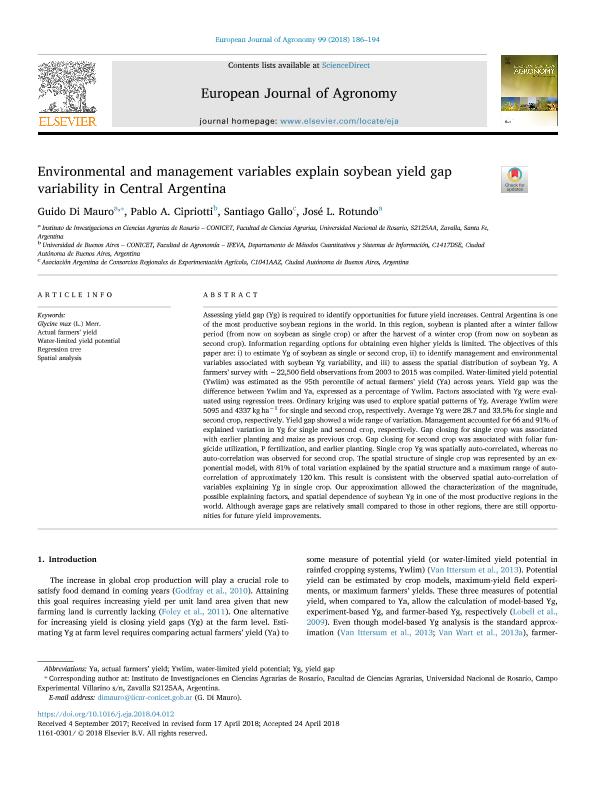Mostrar el registro sencillo del ítem
dc.contributor.author
Di Mauro, Guido

dc.contributor.author
Cipriotti, Pablo Ariel

dc.contributor.author
Gallo, Santiago
dc.contributor.author
Rotundo, José Luis

dc.date.available
2019-11-25T21:33:49Z
dc.date.issued
2018-09
dc.identifier.citation
Di Mauro, Guido; Cipriotti, Pablo Ariel; Gallo, Santiago; Rotundo, José Luis; Environmental and management variables explain soybean yield gap variability in Central Argentina; Elsevier Science; European Journal of Agronomy; 99; 9-2018; 186-194
dc.identifier.issn
1161-0301
dc.identifier.uri
http://hdl.handle.net/11336/90376
dc.description.abstract
Assessing yield gap (Yg) is required to identify opportunities for future yield increases. Central Argentina is one of the most productive soybean regions in the world. In this region, soybean is planted after a winter fallow period (from now on soybean as single crop) or after the harvest of a winter crop (from now on soybean as second crop). Information regarding options for obtaining even higher yields is limited. The objectives of this paper are: i) to estimate Yg of soybean as single or second crop, ii) to identify management and environmental variables associated with soybean Yg variability, and iii) to assess the spatial distribution of soybean Yg. A farmers’ survey with ∼22,500 field observations from 2003 to 2015 was compiled. Water-limited yield potential (Ywlim) was estimated as the 95th percentile of actual farmers’ yield (Ya) across years. Yield gap was the difference between Ywlim and Ya, expressed as a percentage of Ywlim. Factors associated with Yg were evaluated using regression trees. Ordinary kriging was used to explore spatial patterns of Yg. Average Ywlim were 5095 and 4337 kg ha−1 for single and second crop, respectively. Average Yg were 28.7 and 33.5% for single and second crop, respectively. Yield gap showed a wide range of variation. Management accounted for 66 and 91% of explained variation in Yg for single and second crop, respectively. Gap closing for single crop was associated with earlier planting and maize as previous crop. Gap closing for second crop was associated with foliar fungicide utilization, P fertilization, and earlier planting. Single crop Yg was spatially auto-correlated, whereas no auto-correlation was observed for second crop. The spatial structure of single crop was represented by an exponential model, with 81% of total variation explained by the spatial structure and a maximum range of auto-correlation of approximately 120 km. This result is consistent with the observed spatial auto-correlation of variables explaining Yg in single crop. Our approximation allowed the characterization of the magnitude, possible explaining factors, and spatial dependence of soybean Yg in one of the most productive regions in the world. Although average gaps are relatively small compared to those in other regions, there are still opportunities for future yield improvements.
dc.format
application/pdf
dc.language.iso
eng
dc.publisher
Elsevier Science

dc.rights
info:eu-repo/semantics/openAccess
dc.rights.uri
https://creativecommons.org/licenses/by-nc-nd/2.5/ar/
dc.subject
ACTUAL FARMERS’ YIELD
dc.subject
GLYCINE MAX (L.) MERR.
dc.subject
REGRESSION TREE
dc.subject
SPATIAL ANALYSIS
dc.subject
WATER-LIMITED YIELD POTENTIAL
dc.subject.classification
Agricultura

dc.subject.classification
Agricultura, Silvicultura y Pesca

dc.subject.classification
CIENCIAS AGRÍCOLAS

dc.title
Environmental and management variables explain soybean yield gap variability in Central Argentina
dc.type
info:eu-repo/semantics/article
dc.type
info:ar-repo/semantics/artículo
dc.type
info:eu-repo/semantics/publishedVersion
dc.date.updated
2019-10-23T20:58:04Z
dc.journal.volume
99
dc.journal.pagination
186-194
dc.journal.pais
Países Bajos

dc.journal.ciudad
Amsterdam
dc.description.fil
Fil: Di Mauro, Guido. Consejo Nacional de Investigaciones Científicas y Técnicas. Centro Científico Tecnológico Conicet - Rosario. Instituto de Investigaciones en Ciencias Agrarias de Rosario. Universidad Nacional de Rosario. Facultad de Ciencias Agrarias. Instituto de Investigaciones en Ciencias Agrarias de Rosario; Argentina
dc.description.fil
Fil: Cipriotti, Pablo Ariel. Universidad de Buenos Aires. Facultad de Agronomía. Departamento de Métodos Cuantitativos y Sistemas de Información; Argentina. Consejo Nacional de Investigaciones Científicas y Técnicas; Argentina
dc.description.fil
Fil: Gallo, Santiago. Asociación Argentina de Consorcios Regionales de Experimentación Agrícola; Argentina
dc.description.fil
Fil: Rotundo, José Luis. Consejo Nacional de Investigaciones Científicas y Técnicas. Centro Científico Tecnológico Conicet - Rosario. Instituto de Investigaciones en Ciencias Agrarias de Rosario. Universidad Nacional de Rosario. Facultad de Ciencias Agrarias. Instituto de Investigaciones en Ciencias Agrarias de Rosario; Argentina
dc.journal.title
European Journal of Agronomy

dc.relation.alternativeid
info:eu-repo/semantics/altIdentifier/doi/http://dx.doi.org/10.1016/j.eja.2018.04.012
dc.relation.alternativeid
info:eu-repo/semantics/altIdentifier/url/https://www.sciencedirect.com/science/article/pii/S1161030118300947
Archivos asociados
